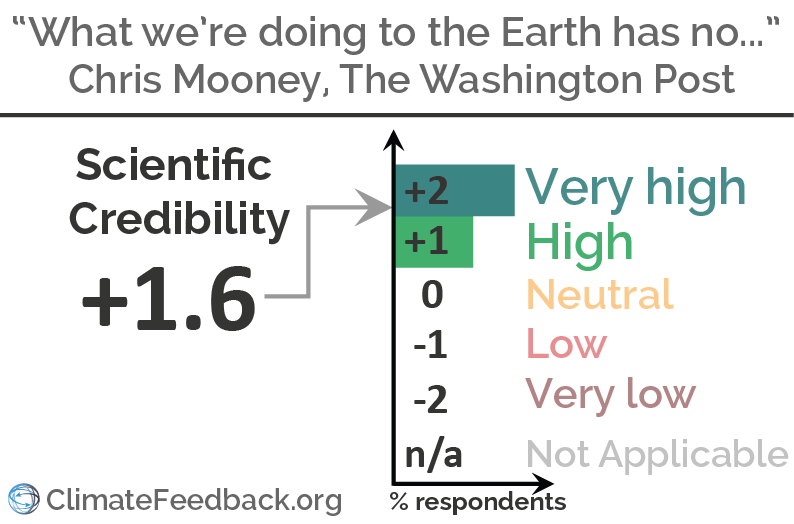- Climate
Analysis of "What we’re doing to the Earth has no parallel in 66 million years, scientists say"
Reviewed content

Published in The Washington Post, by Chris Mooney, on 2016-03-21.

Scientists’ Feedback
SUMMARY
Chris Mooney reports on a new scientific study that shows the current rate of increase of carbon dioxide in the atmosphere is unprecedented in the record of the last 66 million years. The seven scientists who reviewed the article confirmed that it is accurate and insightful.
While a significant die-off of oceanic species coincided with the rapid increase in CO2 that happened around 55 million years ago, the rate of carbon release from human activities today is at least ten times as fast, suggesting the negative consequences on marine life could be greater this time.
See all the scientists’ annotations in context
REVIEWERS’ OVERALL FEEDBACK
These comments are the overall opinion of scientists on the article, they are substantiated by their knowledge in the field and by the content of the analysis in the annotations on the article.
The Washington Post article refers to an article published in Nature Geoscience. In the original scientific article, the authors use an elegant model-data comparison twist to evaluate whether the carbon release was rapid enough to produce a detectable lag in the climate response to the initial carbon release. Although the publication is rather technical, the Washington Post article effectively highlighted the primary message: according to the authors’ best estimate of the carbon release rate, humans might well release carbon ten times more rapidly than what likely happened during the PETM (Palaeocene–Eocene Thermal Maximum). It sadly implies that even the PETM, a massive warm climatic excursion, might not be harsh enough to represent an analogue for future climate change, as the Washington Post rightfully points out.
The article does a very good job in working out the main message of the original scientific paper in an understandable way without oversimplification. The statements are generally correct, except maybe at one point, where it is said that “the researchers used a deep ocean core of sediment”. The sediment core is actually not from the deep ocean but from a rather shallow continental margin site with a high accumulation rate, if I get it right. But this is a minor detail, the main story is conveyed very nicely in this article.

Senior Scientist, Carnegie Institution for Science
Overall, the article seems to me to be a sound representation of the underlying work. Further, the underlying work appears to be sound. Overall, a well done piece. We need a lot more science reporting of this quality.

Professor, University of New South Wales
This is a well written and accurate article.

Postdoctoral Researcher, GFZ Helmholtz Centre Potsdam
I see no problems with this article. It’s a pretty fair representation of one of the key findings of a new paper.
Chris Mooney does a great job of placing the results of this study into a modern context. His statements are well supported by existing peer-reviewed literature.

Research Associate, Harvard University
As far as I can tell, this article accurately reports on a recent paleoclimate study investigating the PETM event and the rate of carbon release during that event. The article conveys the study’s conclusion accurately, i.e., that current, man-made rates of carbon release into the atmosphere are unprecedented.
Notes:
[1] See the rating guidelines used for article evaluations.
[2] Each evaluation is independent. Scientists’ comments are all published at the same time.
Key Take-aways
“about 56 million years ago … The planet proceeded to warm rapidly, at least in geologic terms, and major die-offs of some marine organisms followed due to strong acidification of the oceans.”

Senior Scientist, Carnegie Institution for Science
The event was a “strong acidification” event relative to changes that ordinarily occur over geologic time but it was a weak event compared to what our modern industrial society is threatening to produce.
If anything, Chris Mooney is erring on the side of downplaying risks from ocean acidification by saying that “major die-offs” were associated with a “strong acidification” event, when in fact they have been associated with events that are far weaker than we will produce with continued burning of coal, oil, and gas.

Professor, University of New South Wales
There are several potential causes for the benthic extinctions that are seen in sediment cores. In addition to acidification, abrupt warming of bottom waters, decrease in dissolved oxygen and a potential decrease in food availability (raining down from surface layers) have been put forward in the past (e.g. Thomas [2003] Extinction and food at the seafloor…; Thomas [2007] Cenozoic mass extinctions in the deep sea…; Sluijs et al. [2007] The Palaeocene–Eocene Thermal Maximum super greenhouse…; McInerney and Wing [2011] The Paleocene-Eocene Thermal Maximum: A Perturbation of Carbon Cycle, Climate, and Biosphere with Implications for the Future).
“We’re putting carbon into the atmosphere at an even faster rate than happened back then.”

Professor, PennState University
We are now exceeding by an order of magnitude the rate of carbon release during one of the most remarkable global warming events in Earth’s history.
“In contrast, humans are now emitting about 10 billion tons annually — changing the planet much more rapidly.”

Research Associate, Harvard University
This is the current rate, but it’s worth pointing out that this rate is the result of exponential growth over the last decades, and that it was “only” 1-2 billion tons in the 50’s, for instance.
In drawing the analogy with the PETM, one may also wonder how long the current rates can be sustained – if anything, compared to the 4,000 years of the PETM – given that such emissions are most likely unsustainable over the long-term, either because of fossil fuel availability constraints, or because of the adverse feedback of climate change on human societies.



